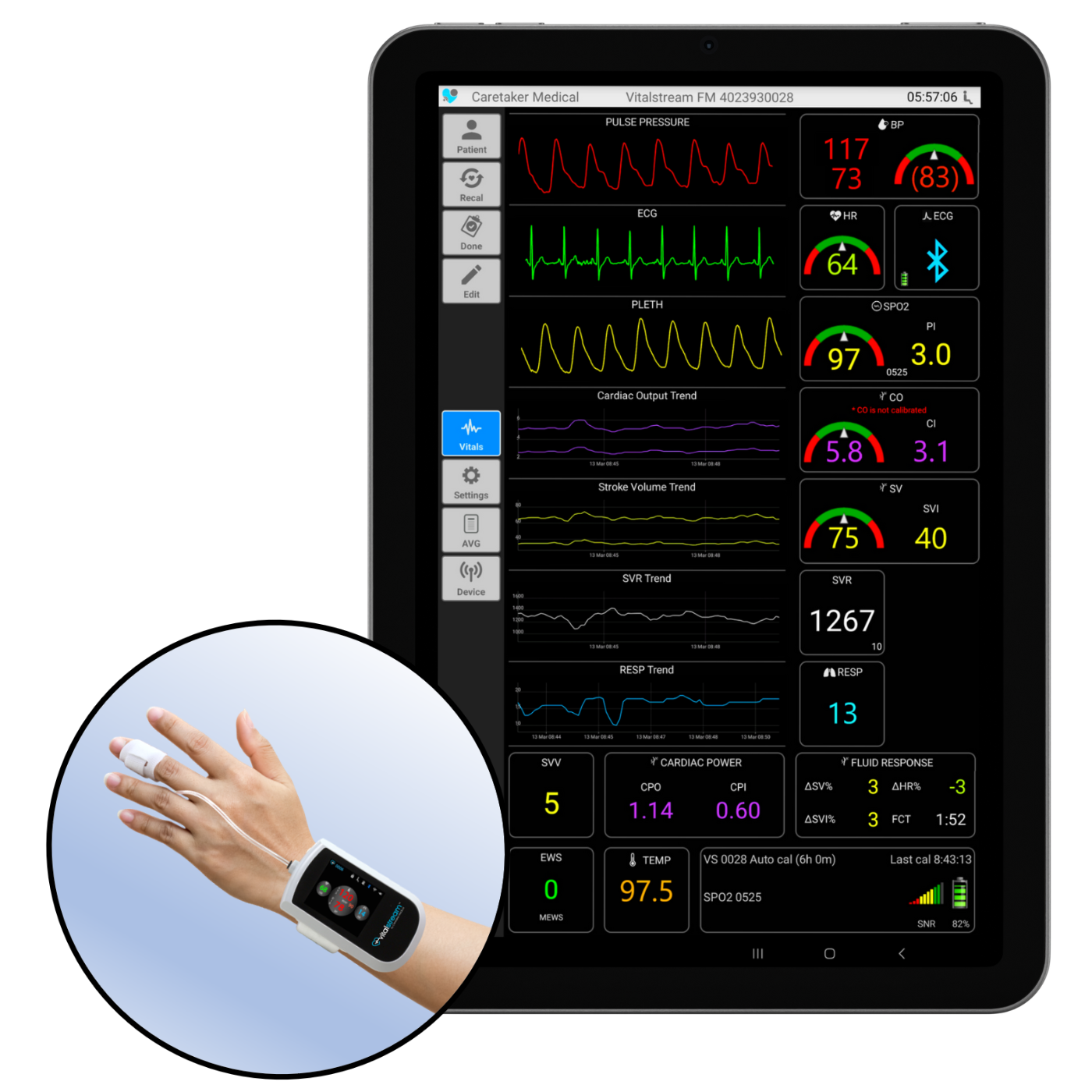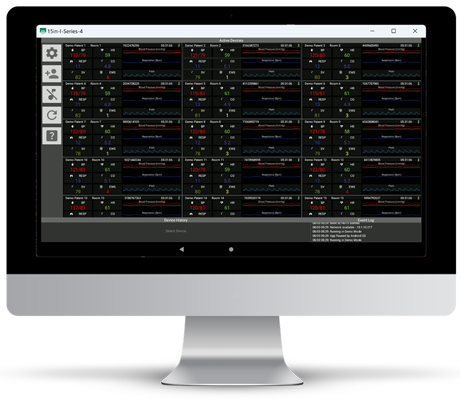VitalStream® for Ambulatory Surgery Centers
Drive efficient, safe and cost-effective care with wireless vital signs monitoring
VitalStream is the only FDA-cleared and clinically-validated wireless, wearable continuous blood pressure, cardiac output and vital signs monitor. The compact and portable device uses a low-pressure finger sensor to comfortably monitor your patients from intake through discharge. This enables early intervention for hemodynamic instability and can reduce the risk of complications including kidney injury and heart failure.
VitalStream uses a patented physiological algorithm, Pulse Decomposition Analysis, to analyze the pulse pressure waveform. It has comparable accuracy to an invasive arterial line and has demonstrated agreement that exceeds other commercially available continuous blood pressure technologies.1

Intraoperative hypotension can also impact ASC patients
Approximately 31% of ASC cases have a MAP <65 mmHg for at least 15 minutes.2
Spot checked blood pressure can lead to delayed event recognition, treatment and therefore adverse clinical outcomes.5
Even brief periods of hypotension are harmful during surgery.3-5

Continuous hemodynamic monitoring has been shown to nearly half the amount of intraoperative hypotension.6
Why VitalStream for ASC patient monitoring?
Enhance patient safety by quickly detecting potential complications with continuous real-time data.
Save time by monitoring your patients from intake through discharge with set up in preop in under 90 seconds.
Eliminate manual vital signs charting with automated documentation.
Enable efficient process with EMR integration and automatic report forwarding.
Move patients without cumbersome wires and decrease the risk of infection with wire-free monitoring.
Gain insights to tailor fluid administration with the touch of a button.
Ensure a pleasant experience for your patients with a comfortable finger sensor that eliminates the need for a brachial cuff and enables mobility.
Drive cost savings with a solution that is a fraction of the cost of traditional monitoring systems.

VitalStation
Leverage central monitoring to drive workflow efficiencies
VitalStation allows you to centrally monitor your patients' vital signs. For large centers, this can save your clinical team valuable time checking on patients. It also ensures that you can monitor your patients in real time to enable timely intervention if needed.
The latest news, webinars and case studies

Virginia Catalyst Awards Caretaker Medical with Grant to Advance VitalStream Development for Improved Patient Outcomes
The Virginia Catalyst, also known as the Virginia Biosciences Health Research Corporation (VBHRC), has awarded $3.18 million in grants to four life and bioscience projects…

Intraoperative Hypotension: A Public Safety Announcement for Anesthesia Professionals
This article from the Anesthesia Patient Safety Foundation Newsletter discusses the modifiable risk of intraoperative hypotension (IOH) and its far-reaching consequences for patients and healthcare…

Using VitalStream for cardiac surgery with Zain Khalpey, MD
We sat down with Zain Khalpey, M.D. Cardiothoracic Surgeon, Director of Artificial Heart, MCS & ECMO, and Chief Medical AI Officer (Network Director) at Honor…
- Kwon Y, Stafford PL, Enfield K, Mazimba S, Baruch MC. Continuous Noninvasive Blood Pressure Monitoring of Beat-By-Beat Blood Pressure and Heart Rate Using Caretaker Compared With Invasive Arterial Catheter in the Intensive Care Unit. J Cardiothorac Vasc Anesth. 2022 Jul;36(7):2012-2021. doi: 10.1053/j.jvca.2021.09.042. Epub 2021 Oct 1. PMID: 34666928; PMCID: PMC8971137.
- Saasouh W, Christensen AL, Chappell D, Lumbley J, Woods B, Xing F, Mythen M, Dutton RP. Intraoperative hypotension in ambulatory surgery centers. J Clin Anesth. 2023 Nov;90:111181. doi: 10.1016/j.jclinane.2023.111181. Epub 2023 Jul 14. PMID: 37454554. https://www.sciencedirect.com/science/article/pii/S0952818023001319?via%3Dihub
- Sessler DI, Bloomstone JA, Aronson S, Berry C, Gan TJ, Kellum JA, Plumb J, Mythen MG, Grocott MPW, Edwards MR, Miller TE; Perioperative Quality Initiative-3 workgroup; POQI chairs; Miller TE, Mythen MG, Grocott MP, Edwards MR; Physiology group; Preoperative blood pressure group; Intraoperative blood pressure group; Postoperative blood pressure group. Perioperative Quality Initiative consensus statement on intraoperative blood pressure, risk and outcomes for elective surgery. Br J Anaesth. 2019 May;122(5):563-574. doi: 10.1016/j.bja.2019.01.013. Epub 2019 Feb 27. PMID: 30916004.
- Josep Solà*, Martin Proença, Fabian Braun, Nicolas Pierrel, Yan Degiorgis, Christophe Verjus, Mathieu Lemay, Mattia Bertschi and Patrick Schoettker. Continuous non-invasive monitoring of blood pressure in the operating room: a cuffless optical technology at the fingertip. DOI 10.1515/cdbme-2016-0060
- Salmasi V, Maheshwari K, Yang D, Mascha EJ, Singh A, Sessler DI, Kurz A. Relationship between Intraoperative Hypotension, Defined by Either Reduction from Baseline or Absolute Thresholds, and Acute Kidney and Myocardial Injury after Noncardiac Surgery: A Retrospective Cohort Analysis. Anesthesiology. 2017 Jan;126(1):47-65. doi:10.1097/ALN.0000000000001432. PMID: 27792044. https://pubmed.ncbi.nlm.nih.gov/27792044/
- Maheshwari K, Khanna S, Bajracharya GR, Makarova N, Riter Q, Raza S, Cywinski JB, Argalious M, Kurz A, Sessler DI. A Randomized Trial of Continuous Noninvasive Blood Pressure Monitoring During Noncardiac Surgery. Anesth Analg. 2018 Aug;127(2):424-431. doi: 10.1213/ANE.0000000000003482. PMID: 29916861; PMCID: PMC6072385.
